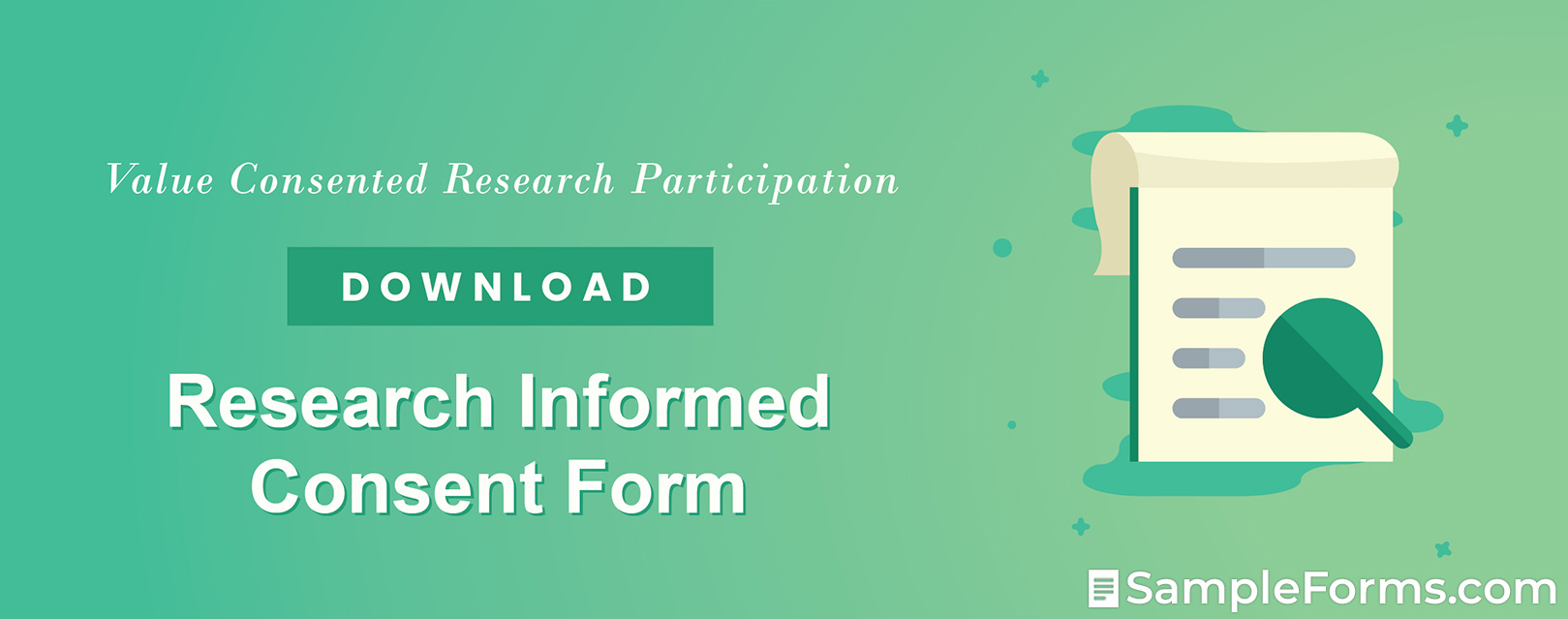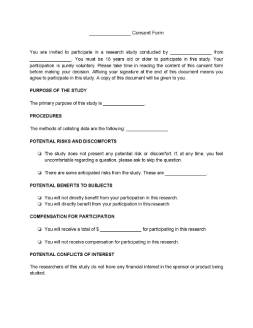- Eviction Notice Forms
- Power of Attorney Forms Forms
- Bill of Sale (Purchase Agreement) Forms
- Lease Agreement Forms
- Rental Application Forms
- Living Will Forms Forms
- Recommendation Letters Forms
- Resignation Letters Forms
- Release of Liability Agreement Forms
- Promissory Note Forms
- LLC Operating Agreement Forms
- Deed of Sale Forms
- Consent Form Forms
- Support Affidavit Forms
- Paternity Affidavit Forms
- Marital Affidavit Forms
- Financial Affidavit Forms
- Residential Affidavit Forms
- Affidavit of Identity Forms
- Affidavit of Title Forms
- Employment Affidavit Forms
- Affidavit of Loss Forms
- Gift Affidavit Forms
- Small Estate Affidavit Forms
- Service Affidavit Forms
- Heirship Affidavit Forms
- Survivorship Affidavit Forms
- Desistance Affidavit Forms
- Discrepancy Affidavit Forms
- Career Assessment - 16+ Examples, Format, Tips, Pdf Forms
- Undertaking Affidavit Forms
- General Affidavit Forms
- Affidavit of Death Forms
Research Informed Consent Form
Research is an essential driving force in any industry. It comes in the form of market analyses or researches that aim to develop innovative marketing strategies. It is also present as clinical trials that help develop new methods and dosages of medication. Regardless of the nature of its implementation, conducting research requires the full participation of its target population. And the first duty of the research team is to gather the voluntary consent of their respondents. A research informed consent document contains all the necessary documents that will help the respondents make an informed decision about joining the research. Read More
Research Informed Consent Form
What Is a Research Informed Consent Form?
A consent form does not only ask for the participant’s permission. It presents the basic information of the research that will help the respondent make the appropriate decision. It is basically a process of introducing the details of the research and the role of the participant. With this document, the respondent will know the potential benefits that they will get from joining. On the flip side, potential risks are also presented but it goes hand in hand with what both parties can do about it. Additionally, this informed consent form acts as a safety net for both parties.
How Do You Construct a Research Informed Consent Form?
Contrary to what most people believe in, consent does not only mean an individual’s agreement to do something. Acquiring informed consent, in particular, requires a process. This process is reflected as separate terms and conditions in a research informed consent form. Before you can collect the signatures and personal information of your respondents, you must inform them of what they will be getting into. If you are looking for a standard on how to write one, here are simple steps that you can follow to get valid consents.
1. Introduce the Foundations of the Research
For a respondent to make their informed consent, they must know what the study is about—primarily, its purpose and methodology. Stating the purpose of the study can be as short as a single sentence. However, when it comes to the methodology, you must be thorough in stating the steps. The respondent must know how the research team will collect the data from them, whether it may be through interviews, experimentation, or through a pen and paper instrument.
2. State Both Possible Benefits and Risks
As part of the research team, you must come clean on how the research will affect the participant. Start with presenting the benefits that the participant will gain if they participate. To add more impact, you can also include the benefits that the research will provide for society. On the other hand, the document must also present the possible risks of the research. Including these pieces of information will let the participant weigh the pros and cons of their decision.
3. Emphasize Confidentiality
Another ethical practice that researchers must practice during the data collection is protecting the confidentiality of their respondents and the data. A significant portion of the informed consent form enumerates the measures that the research team will practice to ensure the participant’s confidentiality. These measures include, but not limited to, the use of pseudonyms or serial numbers when coding the data and the safekeeping of the collected data.
4. Indicate the Rights of the Respondent
The decision of the respondent to participate in the study must be free from any form of coercion. Thus, the document must emphasize the right of the participant to withdraw from the study at any time without incurring any form of consequence. Aside from withdrawal, another right of the respondent is the choice not to answer a question or participate in an activity that they are not comfortable with. Moreover, they must be assured that the refusal to answer does not equate to withdrawal. It serves as a reminder that they can still participate even if they have reservations.
5. Gather the Consent
Expectedly, the last part of the document is the consent statement. At this point, the participant will make their decision. The statement indicates that they read and understood the terms of the arrangement and that they are willing to participate. Once they provide the details that this stipulation requires, the research team will consider them as part of the official pool of respondents.
Frequently Asked Questions
What are the principles of informed consent?
A valid informed consent must have these principles: the context of the research, emphasis on the respondent’s role, alternative options for the respondent, and possible risks. All these elements must be present in the document.
Who is not allowed to give their informed consent?
Almost everyone is eligible to provide their informed consent except minors and individuals who are proven to be incapable of making rational decisions.
Are there other types of consent?
Aside from informed consent, there are other classifications of consent. It can be expressed, implied, and unanimous.
Why is consent important in research?
Informed consent is essential in conducting research studies because of its ethical implications. The research, in general, must follow certain ethical standards such as securing the safety of their respondents. And gathering their consent is one of the many ways to protect the participants.
What are the benefits of informed consent?
One of the benefits of informed consent is it empowers the participant. The participant is granted autonomy to make a decision out of what they know. Aside from that, it also increases the participant’s confidence in the research team because they already have a grasp on what is about to happen and what they can benefit from it.
Conducting research that involves human participation aims to minimize harm and maximize benefit. The first step that researchers do to minimize harm is to make sure that all their respondents provided their consent. Research informed consent forms serve as the material evidence that the participants are well-aware of the purpose and methods of the research study. If you are conducting any type of research now or in the future, make sure that all your respondents sign a research informed consent form.

